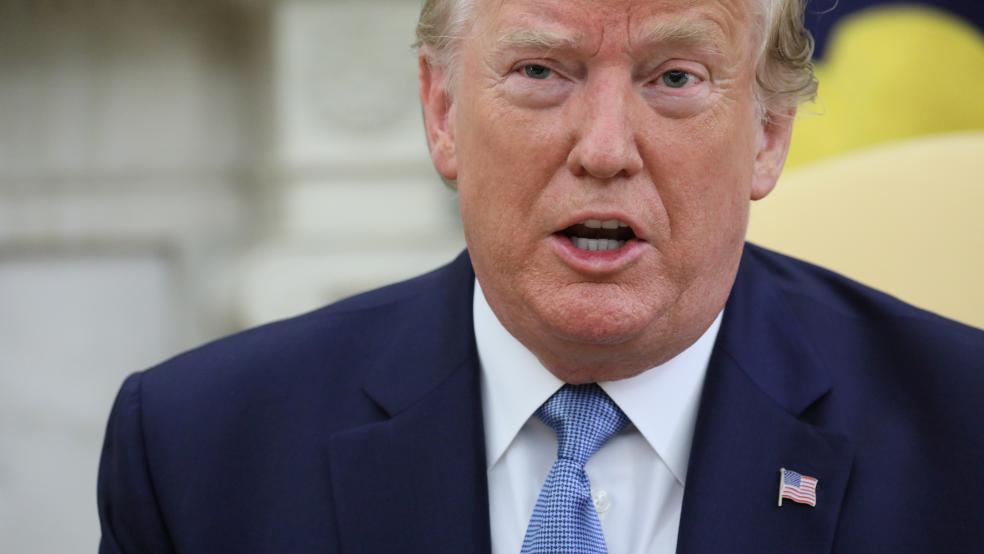President Trump announced Monday afternoon that he had reached a deal with House Speaker Nancy Pelosi and other congressional leaders to raise spending on both defense and non-defense programs over the next two years and suspend the nation’s borrowing limit.
If passed, the agreement would avoid steep automatic cuts set to take effect for fiscal year 2020 and defuse the threat of a possible debt default.
“I am pleased to announce that a deal has been struck with Senate Majority Leader Mitch McConnell, Senate Minority Leader Charles E. Schumer, Speaker of the House Nancy Pelosi, and House Minority Leader Kevin McCarthy — on a two-year Budget and Debt Ceiling, with no poison pills,” the president tweeted. “This was a real compromise to give another big victory to our Great Military and Vets!”
The deal will likely face stiff pushback from fiscal conservatives as well as from Democrats angered over some concessions made by Pelosi and party leaders. But if it passes, it “would amount to an against-the-odds victory for Washington pragmatists seeking to avoid politically dangerous tumult over fiscal deadlines,” Andrew Taylor of the Associated Press wrote before Trump’s announcement. “Nobody can claim a big win, but both sides view it as better than a protracted battle this fall that probably wouldn’t end up much differently.”
Trump and Republicans can point to another year of increased defense spending, while Pelosi and her caucus can say they protected the domestic programs they prioritize. And both sides can breathe a sigh of relief about avoiding a debt crisis that could have shaken markets and the economy.
What’s in the deal: The agreement, according to multiple reports, would:
- Suspend the debt ceiling through at least July 2021.
- Lift spending levels over the next two years by about $320 billion. That total is $30 billion less than Democrats reportedly had wanted, but it does achieve their desired goal of providing equal-sized increases for defense and non-defense outlays. “In the end, domestic programs would on average receive 4% increases in the first year of the pact, with much of those gains eaten up by veterans increases and an unavoidable surge for the U.S. Census,” Taylor says. “Defense would jump to $738 billion next year, a 3% hike.” But economist Ernie Tedeschi notes that if you look at the deal over two years, the annual spending increases are roughly the same as adjusting actual 2019 spending for fairly low levels of inflation.
- Offset some $75 billion of that increased spending, or about half as much as the administration had sought late last week. Those offsets reportedly include extending caps on future Medicare spending and raising customs user fees.
- Allow the decade-long spending caps put in place under the 2011 Budget Control Act to expire. Those caps, meant as an enforcement mechanism for a deficit-reduction deal, were lifted repeatedly over the following years as lawmakers found they couldn’t stomach the required “sequestration” cuts. This would be the fourth deal since 2013 to bust through the caps.
House Democrats hope to pass the deal before they adjourn for a six-week recess on Friday, setting up the Senate to pass the legislation before it departs at the end of next week.
Here’s what else you need to know:
Fiscal hawks are apoplectic. Annual budget deficits are rapidly rising toward $1 trillion — the federal government must borrow a quarter for every dollar it spends, the AP’s Taylor pointed out. The spending levels in this deal would only accelerate that climb, adding about $2 trillion to projected debt levels over the next decade. “[T]his agreement is a total abdication of fiscal responsibility by Congress and the President,” said Maya MacGuineas, president of the Committee for a Responsible Federal Budget. “It may end up being the worst budget agreement in our nation’s history, proposed at a time when our fiscal conditions are already precarious.”
Trump’s support is critical. “It’s very important that we take care of our military. Our military was depleted. In the last two-and-a-half years, we’ve un-depleted it, OK, to put it mildly,” the president told reporters earlier on Monday. “We need another big year.” He has told aides that he plans to have a fight with Congress over spending if he wins reelection, according to The Washington Post, but he’s backing this deal — and the strength of his support will be key to lining up GOP votes. At the same time, outcries from right-wing media and lawmakers have in the past led Trump to back away from such bipartisan agreements, and House conservatives are calling on Trump to reject the deal. Lawmakers know that he hasn’t signed off until he actually puts pen to paper.
Democrats may be taking a risk, too: Bloomberg’s Sahil Kapur noted that the deal could come back to bite Democrats if they defeat Trump in the 2020 elections. “If Democrats win,” he tweeted, “this may force the next president to spend their first six months battling a storm of debt mania, which Republicans historically ignite when they're out of the White House.”
Also, the White House sought assurances from Pelosi that coming spending bills won’t contain controversial “poison pills,” meaning Democrats can’t try to eliminate the Hyde Amendment, which prohibits the use of federal funds for abortion, or place additional limits on the administration’s ability to transfer money for a construction of a border wall. Many Democrats won’t be pleased about those parts of a deal. Pelosi also conceded in her attempt to keep $22 billion in funding for a VA program allowing veterans to see private sector health care providers from counting against the non-defense budget.
Lawmakers still have work to do: With budget levels set, they’ll need to pass spending bills — including the contentious legislation to fund the Department of Homeland Security — before the end of September of again face the prospect of a partial government shutdown.





